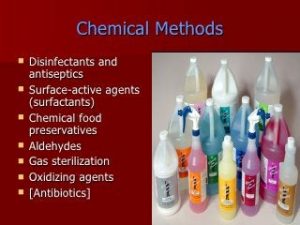Alcohol
Overview.
In the health care setting, “alcohol” refers to two water-soluble chemical compounds, ethyl alcohol and isopropyl alcohol, which generally have underestimated germicidal characteristics. The FDA has not approved any liquid chemical sterilants or high-level disinfectants. level with alcohol as the main active ingredient. These alcohols are rapidly bactericidal rather than bacteriostatic against vegetative forms of bacteria; they are also tuberculocidal, fungicidal, and virucidal, but do not destroy bacterial spores. Its acid activity drops sharply when diluted below 50% concentration, and the optimal bactericidal concentration is 60% to 90% solutions in water.
Action mode.
The most plausible explanation for the antimicrobial action of alcohol is protein denaturation. This mechanism is supported by the observation that absolute ethyl alcohol, a dehydrating agent, is less bactericidal than alcohol-water mixtures because proteins denature more rapidly in the presence of water. Protein denaturation is also consistent with the observations that alcohol destroys Escherichia coli dehydrogenases, that ethyl alcohol increases the lag phase of Enterobacter aerogenes and that the effect of the lag phase could be reversed by adding certain amino acids. The bacteriostatic action was believed to be caused by inhibition of the production of metabolites essential for rapid cell division.
Microbicidal activity.
Methyl alcohol (methanol) has the weakest bactericidal action of the alcohols and is therefore rarely used in health care. The bactericidal activity of various concentrations of ethyl alcohol (ethanol) was examined against a variety of microorganisms in exposure periods ranging from 10 seconds to 1 hour. Pseudomonas aeruginosa was killed in 10 seconds with all concentrations of ethanol from 30% to 100% (v/v), and Serratia marcescens, E. coli and Salmonella typhosa were killed within 10 seconds with all concentrations of 40% ethanol to 100%. Gram-positive organisms Staphylococcus aureus and Streptococcus pyogenes were slightly more resistant and were killed within 10 seconds by 60% to 95% ethyl alcohol concentrations. Isopropyl alcohol (isopropanol) was slightly more bactericidal than ethyl alcohol for E. coli and S. aureus.
Ethyl alcohol, at concentrations of 60% to 80%, is a potent virucidal agent that inactivates all lipophilic viruses (eg, herpes, vaccinia, and influenza viruses) and many hydrophilic viruses (eg, adenoviruses). , enteroviruses, rhinoviruses, and rotaviruses, but not hepatitis A virus (HAV) or poliovirus). Isopropyl alcohol is not active against nonlipid enteroviruses but is fully active against lipid viruses. Studies also have demonstrated the ability of ethyl and isopropyl alcohol to inactivate hepatitis B virus (HBV) and herpes virus, and ethyl alcohol to inactivate human immunodeficiency virus (HIV), rotavirus, echovirus and astrovirus.

In tests of the effect of ethyl alcohol against M. tuberculosis, 95% ethanol killed tubercle bacilli in sputum or aqueous suspension in 15 seconds. In 1964, Spaulding stated that alcohols were the germicide of choice for activity. tuberculocidal, and should be the standard by which all other tuberculocidal products are compared. For example, he compared the tuberculocidal activity of iodophor (450 ppm), a substituted phenol (3%), and isopropanol (70%/volume) using the mucin loop test (106 M. tuberculosis per loop) and determined the times of contact times required for complete destruction were 120 to 180 minutes, 45 to 60 minutes, and 5 minutes, respectively. The mucin loop test is a severe test developed to produce long survival times. Therefore, these figures should not be extrapolated to the exposure times required when these germicides are used on medical or surgical material.
Ethyl alcohol (70%) was the most effective concentration to kill the tissue phase of Cryptococcus neoformans, Blastomyces dermatitidis, Coccidioides immitis, and Histoplasma capsulatum and the culture phases of the latter three organisms aerosolized on various surfaces. The culture phase was more resistant to the action of ethyl alcohol and required about 20 minutes to disinfect the contaminated surface, compared to <1 minute for the tissue phase. Isopropyl alcohol (20%) is effective in removing Acanthamoeba Culbertson cysts (560), as are chlorhexidine, hydrogen peroxide, and thimerosal.
Applications.
Alcohols are not recommended for sterilization of medical and surgical materials primarily because they lack sporicidal action and cannot penetrate protein-rich materials. Fatal postoperative Clostridium wound infections have occurred when alcohols are used to sterilize surgical instruments contaminated with bacterial spores. Alcohol has been used effectively to disinfect oral and rectal thermometers hospital pagers, scissors and stethoscopes. Alcohols have been used to disinfect fiberoptic endoscopes but the failure of this disinfectant has led to infection.
Alcohol wipes have been used for years to disinfect small surfaces such as rubber stoppers multi-dose medication vials or vaccine bottles. In addition, alcohol is occasionally used to disinfect external surfaces of equipment (eg, stethoscopes, ventilators, manual ventilation bags), CPR manikins, ultrasound instruments, or medication preparation areas. Two studies demonstrated the efficacy of 70% isopropyl alcohol for disinfecting reusable transducer heads in a controlled environment. In contrast, three outbreaks of bloodstream infections have been described when alcohol was obtained to disinfect the heads of transducers in an intensive care environment.
Documented deficiencies of alcohols in equipment are that they damage shellac mounts on lensed instruments, tend to swell and weather rubber and certain plastic tubing after prolonged and repeated use, whiten rubber and plastic tiles and damage the tips of the tonometer (due to the deterioration of the glue). ) after the equivalent of 1 year of routine use work. Tonometer biprisms soaked in alcohol for 4 days develop rough front surfaces that could possibly cause corneal damage; this appears to be caused by the weakening of the cementing substances used to fabricate biprisms. Opacification of the cornea has been reported when tonometer tips were rubbed with alcohol immediately prior to measuring intraocular pressure. Alcohols are flammable and therefore, Therefore, they should be stored in a cool, well-ventilated area. They also evaporate quickly, making it difficult to achieve a long exposure time unless items are submerged.

